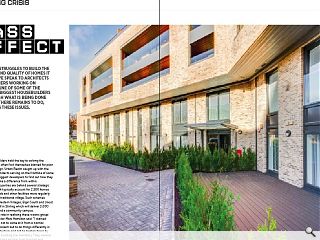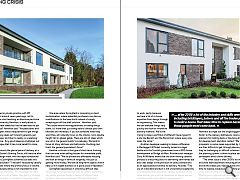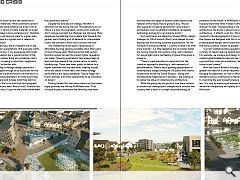Housing Crisis: Mass Effect
23 Apr 2019
As Britain struggles to build the quantity and quality of homes it requires we speak to architects and designers working on the front line of some of the country’s biggest house builders to establish what is being done and what there remains to do, to address these issues.
Britain’s housebuilders hold the key to solving the housing crisis but often find themselves blamed for poor standards of design. Urban Realm caught up with the designers and architects serving on the frontline of some of the country’s biggest developers to find out how they are seeking to make a difference from within.
Springfield Properties are behind several strategic masterplans which typically account for 2,500 homes apiece, plus schools and other facilities more regularly associated with a traditional village. Such schemes include Dundee Western Villages, Elgin South and (most recently) Durieshill in Stirling which will deliver 3,000 houses built around a community campus.
Explaining his role in realising these visions group architectural director Mark Hamilton said: “I started with the intention not to come at it from a normal housebuilders approach but to do things differently in terms of our architecture and not be beaten down by the housebuilders building box mentality. They wanted someone with a strong architectural mindset and background to come at it from a different angle.”
Having worked in private practice with ZM Architecture until around seven years ago, not to mention a 12-year stint teaching architecture part-time at Strathclyde University Hamilton, is well placed to make good on these ideals but has he been able to put them into practice? Hamilton said: “Housebuilders and property developers have a requirement to get things built quickly so any ideas put forward generally get transferred to paper and then to reality in a relatively short space of time. Any good ideas are multiplied out and you could argue that it has more benefit to more people.”
Hamilton contrasts the glacial pace of delivery at a project such as Govan’s Graving Docks, still inactive after seven years of design work, with the rapid turnaround of similarly scaled Springfield schemes but does this make it a volume builder? “I wouldn’t necessarily classify it as a housebuilder where the primary focus is volume. Even the term housebuilding is not important to a lot of companies,” says Hamilton. “No disrespect to them as businesses but in a lot of cases, they just try to make money in different ways. Springfield is more than that and is genuinely trying to do something different.”
One area where Springfield is innovating is client customisation, where potential purchasers can discuss modifications to the base build instead of simply accepting an off the shelf solution. Hamilton said: “This could involve moving partitions or taking things down, it’s more than just being able to choose your own kitchens and worktops. If you ask someone what they want they will naturally focus on the interior, not a double height hall or glazed gable. There are lots of ideas which are not in the general public’s vocabulary. We tend to focus on shiny kitchens and bathrooms, the bling, but that’s the general population’s focus”
Another criticism is the type of short-term thinking that can arise when selling houses for immediate profit. Hamilton said: “We do private and affordable housing and look at things in terms of longevity, not just us getting more money. We look at long-term aspects which help us win repeat business or a good piece of feedback.”
Springfield specialises in unlocking difficult sites which may have been passed over by others, eschewing city centre glamour builds in favour of edge of town locations. Hamilton continued: “We tend to look at challenging sites where others have tried to get projects to work, partly because we have a lot of in-house expertise from design through to engineering. That means we can evaluate things very quickly and look at innovative delivery methods. We’re not trying to make a portfolio of different house types fit a site like Barratt and the Persimmon where every site looks the same.”
Another developer seeking to make a difference is Mactaggart & Mickel, currently locked in a legal battle with the Scottish government over a 600-home development at Bridge of Allan. Architectural manager Chris McWilliams warns that the slow-moving consent process is a recurring block to delivering new homes but also cites delays in the provision of utility connections as an appreciable hindrance to delivery. He adds: “The use of a standard product is not universally accepted by all local authorities; therefore, various iterations of the same house type must be developed to ensure we are complying with local planning requirements.”
Returning to Springfield Urban Realm asked Hamilton to single out the single biggest contributory factor to the delivery bottleneck, raising a finger at planners for holding back or blocking attractive sites for development. Hamilton replied: “We bring forward proposals, in some cases supported by the council, which are then difficult to get through planning not because they’re challenging or difficult schemes but because the planning system is there to place barriers in front of developers which slows delivery.
“The other issue is after 2008 a lot of the industry and skills went elsewhere including bricklayers, joiners and all the trades you need to build a house. That takes time to replace, because a lot of those people won’t come back and there’s not enough focus on apprentices. Working on a cold and wet building site is not as attractive as sitting on an iPad blogging.”
Is Hamilton happy with the degree of freedom afforded to him and does he have the resources to budget for quality materials? What constraints remain? “Every site has to be viable whether we throw a lot of money at a house in terms of costly materials or larger design moves to make it more contemporary”, Hamilton notes. “Houses of a set size and scale for a given area are still benchmarked at a typical cost in relation to everything else around.
“On the one hand yes, there’s freedom but on the other are the public’s expectations. Not everyone wants a flat roof or a glass box. In my experience, that might be 10% of the population but a typical portion of the population want a certain thing and sometimes that’s what they’re used to seeing or what their neighbours have or what they’re familiar with.
“My role is trying to manage design aspirations while making it appeal enough to be successful for the business. I have got the ammunition to do that but it is within certain sensible parameters to make sure things still stack up. People tend to base what they want on what they’ve seen. We try to push that by saying well ‘what colour car do you want. Red or blue?’ In actual fact they want a black one, it’s just no one’s ever shown them the possibilities before.”
Despite the slow pace of change, Hamilton is optimistic for the future. He said: “Housebuilding by its nature is a slow-moving beast, construction methods don’t change overnight but lifestyles are changing. More people are considering how to relate their house to the garden, we’re finding a lot of demand for intermediate rooms like sunrooms which try to connect the two.”
One notable trend has been a renaissance in affordable housing, growing available stock after years of council house sales. Working across both sectors Hamilton knows full well the impact tighter regulation can make: “Housing associations have always been at least one step ahead of the private sector to satisfy building regs. There have been grants to deliver to a higher standard than the base level, creating houses which are better in their fabric with better energy performance and space standards. They’re larger and there’s perhaps a bit more opportunity to be innovative on design.”
Putting forward his own observations on how house buyer priorities are shifting McWilliams said: “A lot of house buyers understand the flexibility they have and how they can adapt or extend certain layouts and features of the house they’re going to buy. We are also seeing an increasing demand for new products and features such as ultrafast broadband, renewable technology and electric car charging points.”
Such sentiments are shared by Stewart Milton, design manager for CALA Homes (West), who relayed his own experiences of evolving customer expectations: “At the moment, the housing market – in terms of what’s on offer more broadly – is a little repetitive, but consumer tastes are moving towards 21st century living, with a demand for natural light and a real feeling of space throughout a property.
“There’s a real aspiration to stand out from the crowd as opposed to blending in, with elements of personalisation. There’s also a growing appreciation of contemporary design among the UK public who, thanks to television shows like Grand Designs – along with homebuilding magazines and websites – are waking up to realise the value of contemporary architecture.”
While the going may be good for now there remains a concern that demographic changes and a construction industry that is stuck in its ways could be storing up problems for the future. Is McWilliams confident that housebuilders have what it takes to effect genuine change? He said: “Housebuilding is the ‘reality’ of architecture, the home is where most people meet architecture - it affects us all. So, I think it’s important to respond to the demographics of your buyer, it’s essential that houses are designed with this in mind and that we produce good designs which build strong communities that have a positive impact on people’s lives.
“Current Scottish building regulations cater for a variety of needs covering several demographics. For example, we produce and design homes with unobstructed disabled access and we can easily convert a ground floor room into a bedroom, depending on the house buyer’s needs.”
With the scale of Britain’s housing crisis growing ever greater the need for a unified response grows with it. Bringing housebuilders on-side in efforts to raise design standards across construction is therefore vital if we are to overcome the ever-present pressure to do more with less. It is only by exploring all avenues available to us can we deliver the quantity and quality of homes needed for the future.
|
|





